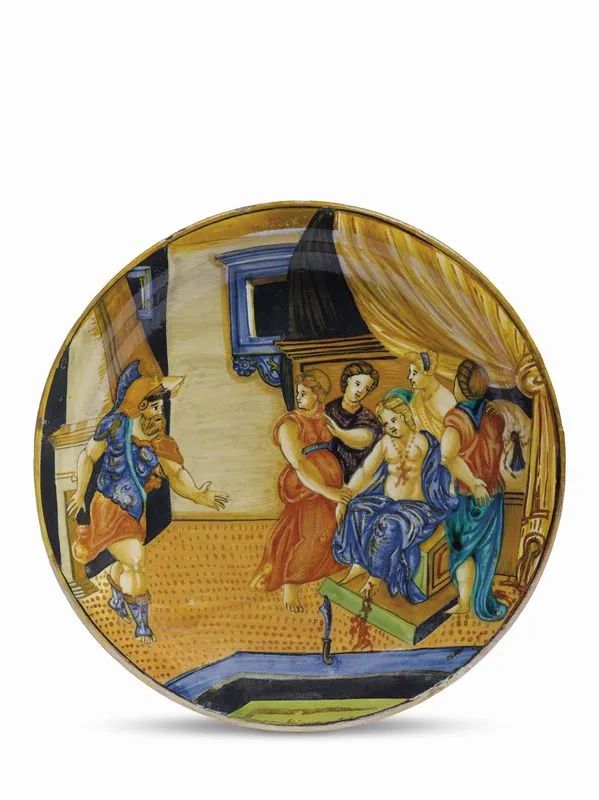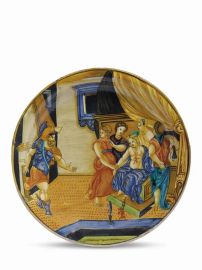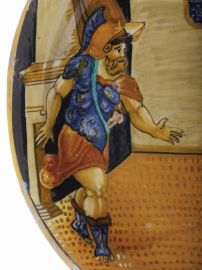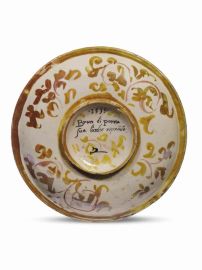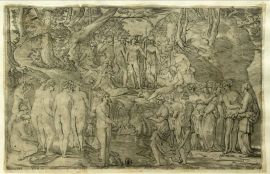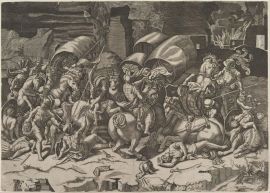SHALLOW BOWL, URBINO, OF THE CIRCLE OF FRANCESCO XANTO AVELLI, PAINTER “LU UR” (“L”), LUSTERED IN GUBBIO OR IN URBINO (“N”), 1535
SHALLOW BOWL
URBINO, OF THE CIRCLE OF FRANCESCO XANTO AVELLI, PAINTER “LU UR” (“L”), LUSTERED IN GUBBIO OR IN URBINO (“N”), 1535
High cm 4, diam. cm 25,2, foot diam. cm 10,4
Polychrome earthenware painted in two shades of green, cobalt blue, yellow, yellow-orange, brownish manganese, golden lustre and ruby.
On the back, inscription in black manganese: .1535./Bruto di porzia/Sua l’ardie ripre[n]de/L; N mark in lustre
Provenance
Robert Bak, New York (even if not included in the sale of the collection, Sotheby’s, London, December, 7th 1965);
Sprovieri Collection, Rome;
Private Collection, Milan
Literature
J.V.G. Mallet, Xanto: i suoi compagni e seguaci, in “Francesco Xanto Avelli da Rovigo. Atti del Convegno Internazionale di Studi 1980”, Rovigo 1988, p. 76 note 47;
T. Wilson, Il pittore di maiolica “Lu Ur”, in “Fimantiquari” 2, no. 2, 1993, fig. 9, 10;
T. Wilson, Italian Maiolica of the Renaissance, Milan 1996, pp. 227-229 no. 96
This shallow bowl presents a concave moulding with a short edge ending with a thin rounded rim and stands on a short foot with a jetting rim. The decoration is particularly rich in enamel and pigments, as evident in the use of black manganese, yellow-orange, made more vibrant through small parallel dots in lustre, and lustre cobalt blue with tin-glazed shadings.
Complex and full of pathos, the scene develops through the entire bowl length including the cavetto: it portrays a closed room with a high fireplace, a decorated window and some steps where the figure of Portia stands out, sitting on a high-backed chair surmounted by a canopy and surrounded by her handmaids. She has just found out about the conspiracy of her husband, Marcus Junius Brutus, against Julius Caesar and has promised to kill herself in the case the plot had failed. To prove her courage and her determination, she is depicted while hurting her foot. After Brutus' death, his wife keeps her promise and kills herself by swallowing hot coals.
The theme represented is the resistance to tyranny until the extreme sacrifice of the life to keep the honour. In ancient times this theme was widely discussed: Dante, for example, judges Portia as a traitor, while Petrarch praises her as a symbol of virtue against tyranny. Timothy Wilson, who studied this work, mentions the influence of Xanto Avelli and of his Petrarchism on many artists of his circle.
The painting technique is fast. It does not apparently seem that this artist was strongly influenced by the engravings of the time. It is more likely that he took inspiration from them as evident in some figures of this dish: from the engraving, the Battaglia del coltellaccio by Marco da Ravenna (Bartsch XIV, p. 171, no. 211) derives the figure of Brutus, here depicted with the head turned in the opposite direction (see fig. 1), while the female figures (see fig. 2) are drawn up from the engraving The Contest between the Muses and the Pierides by Giangiacomo Carraglio after Rosso Fiorentino (Bartsch 28, p. 186, no. 53).
The back of the dish is decorated with folds in golden lustre around thin ruby spirals: among these the letter “N” stands out in the centre near the inscription with the date of the dish, the description of the scene and the signature. With regard to these characteristics, it is worth mentioning the description of the back of a dish published by John Mallet (Xanto. Pottery-painter, Poet, Man of the Italian Renaissance, exhibition catalogue, Wallace Collection, London 2007, pp. 88-89), and the statements of C. Fiocco and G. Gherardi on the dating of the lustre bowls (La bottega di Maestro Giorgio Andreoli e il problema dei lustri a Urbino, in “Faenza” XCIII, 2007, pp. 209-306).
The technique and the style of this dish prove a close relationship of this artist with Francesco Xanto Avelli and his signature. An exhaustive study on his signature, often visible in works with double lustre, has brought to the identification with the artist called " Lu Ur ". At first, John Mallet believed that the painter signed his works with the symbol of a hook in the years around 1535 (Istoriato-painting at Pesaro: I: The Argus Painter, in “Faenza” 66, 1980, pp. 159-160, where the signature is attributed to the Argonaut painter). Later, he ascribed to this author the works signed with the letter “L” (Xanto: i suoi compagni e seguaci, in “Francesco Xanto Avelli da Rovigo. Atti del Convegno Internazionale di Studi 1980”, Rovigo 1988, pp. 75-76). In his publication (Italian Maiolica of the Renaissance, Milan 1996, pp. 203-205 and pp. 212-214), Timothy Wilson at first identified the signature with the letter “L”, which was present in some works dated 1535, and then extended it as part of the signature “Lu Ur”.
The list of dishes described by Timothy Wilson (cit. p. 228 fig. a; p. 230 fig. c and b) have contributed to give a useful interpretation also of the works without signature, like, for example, an allegorical dish at the Manchester City Gallery, or another one depicting Picus and Circe at the Ashmolean Museum of Oxford or a mythological dish depicting Mercury and Argus in a private collection, which, however, does not seem to be stylistically close to the other two. New comparative elements can, however, be added between the anonymous works and those signed or ascribable to this pupil of Avelli, who probably worked together with the master. One of these signed worked was presented by our auction house last year (G. Anversa, Importanti maioliche rinascimentali, Florence 2016, pp. 150-155 no. 33).
According to the stylistic analysis previously made by some scholars, we can confirm that the works of this painter of Urbino are characterized by some common elements like, for example, the irregular compositional arrangement of the figures, the shape of the eyes with a small white dot (this feature is also present in some other works signed by the author in collaboration with Avelli) and a certain expressive freedom in the representation of the figures. An emblematic example is the bowl with the Murder of Oropaste King of Persia (E. Sannipoli, La via della ceramica tra Umbria e Marche: maioliche rinascimentali da collezioni, Gubbio 2010, 2.39): here the style of the faces and the feet is very similar to our dish but, above all, the figure on the left of the scene closely resembles the figure of Brutus of our plate.
This work, rich in highlights, typical of the workshop of the master Giorgio Andreoli of Gubbio, is signed with the letter "N". According to recent studies that have rejected the hypothesis that the works dated between 1530 and 1535 were brought to Gubbio to be lustred, the lustre application was probably applied directly in Urbino by masters coming from Gubbio upon request or commission, even for very long periods. This supposition is furthermore confirmed by the purchase in 1538 of the workshop of Nicola of Urbino by Vincenzo, son of Giorgio Andreoli, in order to open a subsidiary workshop for his activity (C. Fiocco, G. Gherardi, La bottega di Maestro Giorgio Andreoli e il problema dei lustri a Urbino, in “Faenza” XCIII, 2007, pp. 299-306).
